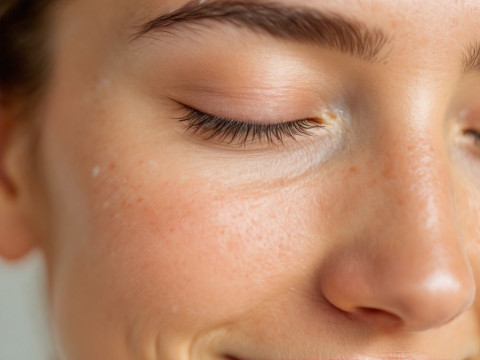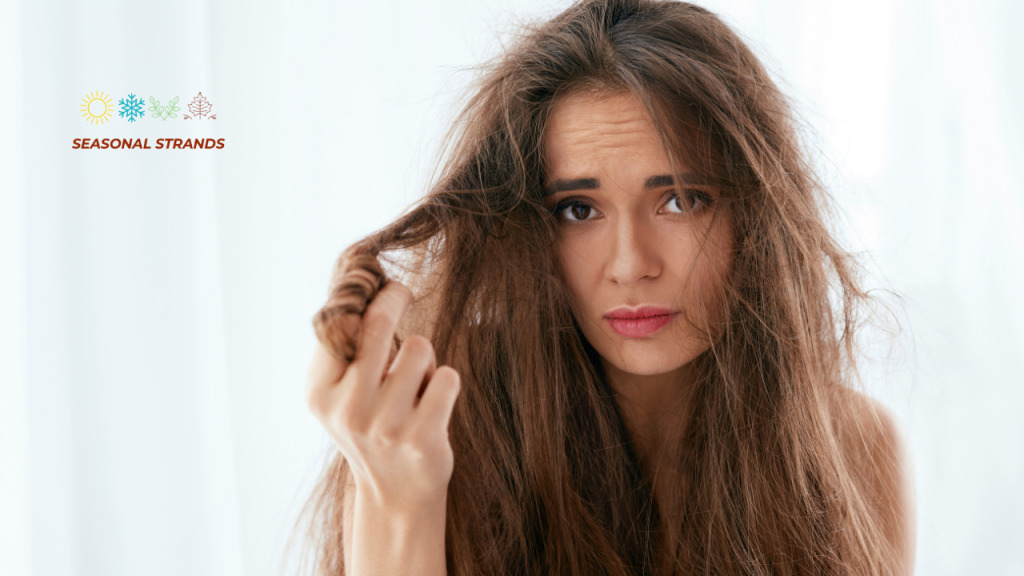Swimming should be refreshing and fun, not a source of hair horror stories. Yet millions of swimmers experience devastating chlorine hair damage every summer, watching their gorgeous locks transform into dry, brittle, greenish straw after just one pool session.
Chlorine hair damage isn’t just cosmetic – it’s a serious threat to your hair’s structural integrity. Each exposure strips protective oils, lifts cuticles, and breaks down the protein bonds that give your hair strength and elasticity. Without proper protection, what starts as minor dryness quickly escalates to breakage, color fading, and that telltale green tint that screams “pool hair.”
But here’s the empowering truth: Chlorine hair damage is completely preventable when you know the right strategies. These 5 scientifically-proven methods will shield your hair before, during, and after swimming, allowing you to dive in with confidence.
Let’s explore how to stop chlorine hair damage in its tracks and keep your hair healthy all summer long.
Understanding Chlorine Hair Damage: The Science Behind Pool Destruction
How Chlorine Hair Damage Occurs
Chlorine works as a powerful oxidizing agent designed to eliminate bacteria and organic matter in pools. Unfortunately, your hair falls squarely into the “organic matter” category, making it a prime target for chemical attack.
The moment your hair touches chlorinated water, several destructive processes begin simultaneously. Chlorine immediately strips away your hair’s natural sebum (protective oil layer), leaving the hair shaft vulnerable to further chemical penetration. This initial assault causes the outer cuticle layer to lift and roughen, creating that familiar post-swim texture that feels like sandpaper.
As chlorine penetrates deeper into the hair shaft, it breaks down keratin proteins and disrupts the disulfide bonds that maintain your hair’s structure. This protein degradation is what causes the characteristic weakness and brittleness associated with severe chlorine hair damage.
The Infamous Green Tint: Why Chlorine Hair Damage Shows Color
The green discoloration that many swimmers experience isn’t actually from chlorine itself, but from copper compounds that chlorine helps oxidize. Pool maintenance often involves copper-based algaecides, and when chlorine oxidizes these copper ions, they become highly reactive and bind to damaged, porous hair.
Blonde and light-colored hair shows green tinting most dramatically because there’s less natural pigment to mask the copper deposits. However, all hair colors experience some level of mineral buildup that contributes to dullness and texture changes.
Risk Factors That Accelerate Chlorine Hair Damage
Color-treated hair faces the highest risk because chemical processing already compromises the hair’s protective barrier. The artificial pigments used in hair dye are particularly vulnerable to chlorine’s oxidizing effects, leading to rapid fading and unwanted color shifts.
Fine hair shows chlorine hair damage more quickly because it has less mass to absorb chemical assault. Previously damaged hair from heat styling, chemical treatments, or environmental stress becomes increasingly porous with each chlorine exposure, creating a cycle of accelerating damage.
The 5 Proven Ways to Prevent Chlorine Hair Damage
🛡️ Method 1: Pre-Pool Saturation and Protective Barriers
The most effective defense against chlorine hair damage starts before you even see the pool. Hair can only absorb a limited amount of liquid, so saturating it with clean water creates a protective barrier that significantly reduces chlorine penetration.
The saturation technique: Spend 2-3 minutes thoroughly wetting your hair with fresh, chlorine-free water. Your hair should be completely soaked, not just damp. This simple step can reduce chlorine hair damage by up to 70%.
Enhanced protection through barrier products: After saturation, apply products that create additional chemical barriers. Look for formulations containing silicones, natural oils, or specialized swimming ingredients that coat the hair shaft and repel chlorinated water.
🏆 Best Products for Preventing Chlorine Hair Damage:
- Malibu C Swimmers Protection ($16) – Specialized formula that neutralizes chlorine on contact
- Paul Mitchell Sun Shield Conditioning Spray ($18) – Dual protection against UV and chlorine
- Pure Coconut Oil ($8) – Natural penetrating barrier that strengthens hair
- Leave-in Conditioner + Argan Oil Blend ($15 total) – DIY protective combination
Application strategy: Focus protective products on mid-lengths and ends where chlorine hair damage appears first. Comb through for even coverage, then style hair up and away from shoulders to minimize water contact during swimming.
🏊♀️ Method 2: Physical Protection and Strategic Styling
Physical barriers provide the strongest defense against chlorine hair damage by limiting direct water contact. While no method is 100% foolproof, combining physical protection with chemical barriers creates multiple layers of defense.
Swimming cap effectiveness: Quality silicone caps reduce chlorine exposure by 85-95% when properly fitted. They’re absolutely essential for anyone serious about preventing chlorine hair damage, especially those with color-treated or chemically processed hair.
Protective hairstyles for uncapped swimming:
- Tight high bun: Elevates most hair above water level
- French braid: Protects length while allowing comfortable movement
- Double Dutch braids: Secure styling that minimizes chlorine contact
- Twisted chignon: Quick updo that keeps hair compressed and protected
🏆 Best Physical Protection Products:
- Speedo Silicone Swim Cap ($12) – Superior fit and chlorine resistance
- TYR Competition Swim Cap ($8) – Budget-friendly protection for regular use
- SOUL CAP ($35) – Designed specifically for voluminous, textured hair
- Silicone Hair Ties ($6) – Waterproof accessories that maintain protective styles
🚿 Method 3: Immediate Post-Swim Chlorine Neutralization
The first 5 minutes after swimming represent a critical window for preventing permanent chlorine hair damage. Quick action can neutralize chlorine before it causes irreversible structural changes to your hair.
The emergency rinse protocol: Immediately rinse hair with fresh water for at least 3 minutes, ensuring water runs completely clear. This dilutes chlorine concentration and begins the neutralization process before damage becomes permanent.
Chlorine-neutralizing treatments: Use shampoos specifically formulated to neutralize chlorine rather than just washing it away. These products contain ingredients that chemically bind to chlorine molecules, making them easier to remove and preventing further damage.
DIY emergency neutralization: When specialized products aren’t available, mix 1 cup water with 1 tablespoon baking soda for an alkaline rinse that helps neutralize acidic chlorine compounds and halt ongoing damage.
🏆 Best Post-Swim Chlorine Hair Damage Prevention:
- UltraSwim Chlorine Removal Shampoo ($6) – Immediate chlorine neutralization
- Malibu C Swimmers Shampoo ($17) – Gentle yet effective chemical removal
- Paul Mitchell Clarifying Shampoo Three ($24) – Professional-grade cleansing
- Neutrogena Anti-Residue Shampoo ($5) – Accessible option for occasional swimmers
Technique for maximum effectiveness: Apply neutralizing shampoo to wet hair, massage thoroughly into scalp and lengths, leave for 2-3 minutes to allow chemical neutralization, then rinse completely and follow with moisturizing conditioner.
🔬 Method 4: Weekly Deep Cleansing to Prevent Chlorine Hair Damage Buildup

Regular swimmers need intensive weekly treatments to remove accumulated chlorine and mineral deposits that cause progressive damage. Standard shampoos can’t eliminate the deep-penetrating compounds that create long-term chlorine hair damage.
Chelating vs. clarifying for chlorine hair damage: Clarifying shampoos remove surface buildup, while chelating treatments use specialized ingredients like EDTA to bind with metal ions and chlorine compounds for complete elimination from the hair shaft.
Progressive treatment schedule:
- After each swim: Immediate rinse and gentle chlorine-removing shampoo
- Weekly: Intensive chelating treatment followed by deep conditioning
- Bi-weekly: Protein treatment to repair structural chlorine hair damage
- Monthly: Professional assessment and treatment adjustment
🏆 Best Deep Cleansing Products for Chlorine Hair Damage:
- Malibu C Hard Water Wellness Kit ($36) – Complete mineral and chlorine removal system
- Ion Crystal Clarifying Treatment ($8) – Affordable chelating option for budget-conscious swimmers
- Redken Hair Cleansing Cream ($28) – Professional salon-grade treatment
- Apple Cider Vinegar Rinse ($3) – Natural chelating agent for mild buildup
💧 Method 5: Intensive Repair for Existing Chlorine Hair Damage
Once chlorine hair damage occurs, strategic repair treatments can restore hair health and prevent further deterioration. The key is addressing both protein loss and moisture depletion that characterize chlorine damage.
Damage assessment technique: Perform a wet strand test to determine repair needs. If hair breaks immediately when stretched, you need protein treatments. If it stretches excessively without breaking, focus on moisture restoration.
Rotating repair protocol:
- Week 1: Protein treatment to rebuild damaged hair structure
- Week 2: Deep moisture treatment to restore hydration balance
- Week 3: Combination treatment addressing both protein and moisture needs
- Week 4: Maintenance treatment based on ongoing chlorine exposure
🏆 Best Chlorine Hair Damage Repair Products:
- Olaplex No. 3 Hair Perfector ($30) – Rebuilds bonds broken by chlorine exposure
- SheaMoisture Manuka Honey Intensive Hydration Mask ($13) – Deep moisture restoration for dry, damaged hair
- Aphogee Two-Step Protein Treatment ($25) – Intensive structural repair for severe chlorine hair damage
- DIY Coconut Oil + Honey Mask ($10 total) – Natural intensive treatment for budget-conscious repair
Application for maximum repair: Apply treatments to clean, towel-dried hair. Use gentle heat from a blow dryer or warm towels to enhance product penetration. Follow timing instructions precisely – over-treatment can worsen chlorine hair damage.
Chlorine Hair Damage Prevention by Hair Type
Color-Treated Hair: Maximum Protection Required
Color-treated hair suffers the most severe chlorine hair damage because existing chemical processing compromises the hair’s natural protective barriers. Artificial pigments are particularly vulnerable to chlorine’s oxidizing effects.
Enhanced protection strategy:
- Never swim without a cap if you have recently colored hair
- Use color-safe, sulfate-free products exclusively
- Increase protective treatment frequency to twice weekly
- Rinse with cool water to seal cuticles and lock in color
🏆 Best Products for Color-Treated Hair:
- Redken Color Extend Magnetics Shampoo ($24) – Color protection with gentle cleansing
- Pureology Hydrate Shampoo ($32) – Sulfate-free formula that prevents fading
Natural Hair: Maintaining Texture and Preventing Chlorine Hair Damage
Unprocessed natural hair handles chlorine better than chemically treated hair but still requires protection to maintain texture and prevent the dryness that leads to breakage.
Natural hair protection approach:
- Focus on moisture retention and pH balance maintenance
- Use natural oils like coconut, jojoba, or shea butter for protection
- Choose gentle, sulfate-free cleansing products
- Regular protein treatments to maintain hair strength against chemical assault
Fine Hair: Preventing Limpness from Chlorine Hair Damage
Fine hair shows the effects of chlorine hair damage most quickly, becoming limp, lifeless, and difficult to style. Lightweight protection that doesn’t weigh hair down is essential.
Fine hair strategy:
- Use silicone-free protective products to avoid buildup
- Gentle clarifying treatments to prevent product accumulation
- Volumizing treatments to restore body lost to chlorine exposure
- Minimal product application to maintain natural movement
Emergency Chlorine Hair Damage Control

Immediate Actions for Severe Damage
When you notice green tints, extreme dryness, or dramatic texture changes, immediate intervention can prevent permanent chlorine hair damage and restore hair health.
Emergency green tint removal methods:
- Tomato ketchup treatment: Apply to affected areas, leave 20 minutes, rinse thoroughly
- Aspirin paste: Crush 6 tablets, mix with water, apply for 15 minutes to neutralize copper deposits
- Clarifying shampoo + baking soda: Mix equal parts for intensive mineral removal
Signs requiring professional intervention:
- Green discoloration that doesn’t respond to home treatments
- Hair that feels gummy or elastic when wet
- Excessive breakage or shedding after chlorine exposure
- Complete loss of natural curl pattern or texture
Professional Treatment Options
Severe chlorine hair damage may require professional intervention. Colorists and hair restoration specialists have access to stronger chelating agents and can assess whether damage is reversible or requires cutting.
When to seek professional help:
- Persistent color changes despite home treatment efforts
- Structural damage affecting hair’s ability to hold moisture
- Progressive thinning or breakage patterns
- Hair that no longer responds to conditioning treatments
Conclusion
Chlorine hair damage doesn’t have to be the price you pay for enjoying swimming. These 5 proven prevention and treatment methods – pre-swim protection, physical barriers, immediate neutralization, weekly deep cleansing, and intensive repair – create a comprehensive defense system that keeps your hair healthy and beautiful.
The key to preventing chlorine hair damage lies in consistency and using the right combination of techniques for your hair type and swimming frequency. Start implementing these strategies today, and transform your relationship with the pool from one of anxiety to pure enjoyment.
Your hair can be both swim-ready and gorgeous – no compromise necessary!
Frequently Asked Questions
Q: How quickly does chlorine hair damage occur? A: Chlorine hair damage begins immediately upon contact. Minor effects like dryness appear after one swim, while visible damage like green tints and severe texture changes develop with repeated exposure over days or weeks.
Q: Can you reverse chlorine hair damage completely? A: Early-stage chlorine hair damage is often reversible with proper treatment. However, severe structural damage may be permanent, requiring cutting damaged sections and focusing on preventing further damage.
Q: How often should swimmers treat chlorine hair damage? A: Prevention is daily (rinse after every swim), clarifying treatments 2-3 times weekly for regular swimmers, and intensive repair treatments weekly or as needed based on damage level.
Q: Do swimming caps prevent all chlorine hair damage? A: Quality caps reduce chlorine exposure by 85-95% but aren’t completely waterproof. Combine cap use with pre-swim protection and post-swim treatments for maximum effectiveness.
Q: What causes the green tint in chlorine hair damage? A: Green discoloration comes from oxidized copper compounds in pool water that bind to damaged, porous hair. Chlorine facilitates this oxidation process, making proper protection essential.
Q: Is chlorine hair damage worse for certain hair colors? A: Light-colored and chemically-treated hair show chlorine hair damage most dramatically, but all hair types and colors can experience structural damage, dryness, and mineral buildup.
Q: Can you prevent chlorine hair damage with natural products? A: Yes! Coconut oil, apple cider vinegar, and other natural ingredients can effectively prevent and treat mild chlorine hair damage. However, severe damage may require specialized products.
Q: How long after swimming should you treat chlorine hair damage? A: Immediate action within 5 minutes is ideal for preventing chlorine hair damage. However, treatment within a few hours can still be effective for minimizing long-term effects.
Stop Chlorine Hair Damage Before It Starts!
Ready to enjoy unlimited swimming without sacrificing your hair’s health and beauty? Discover more expert strategies for preventing chlorine hair damage on StrandSeasons.com.










